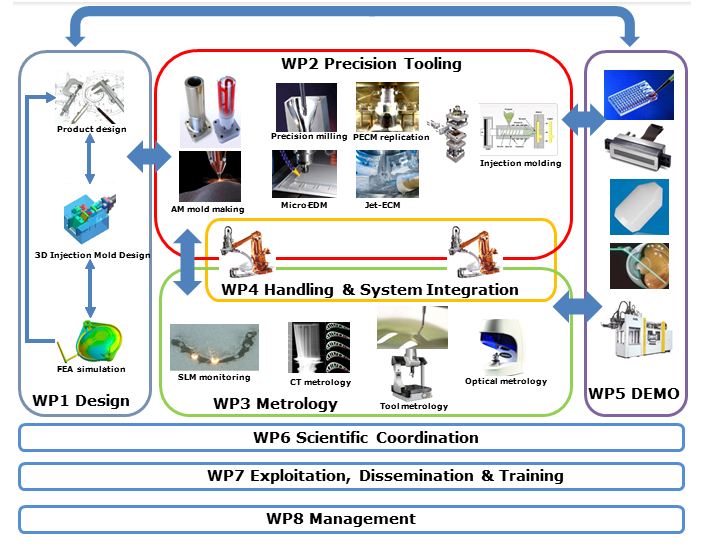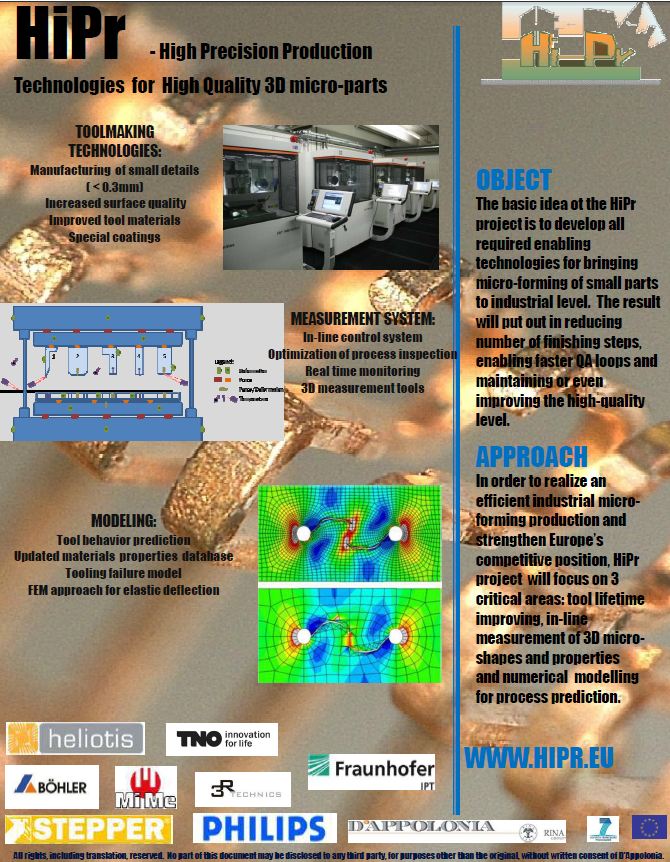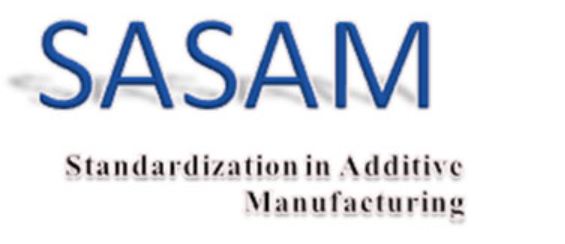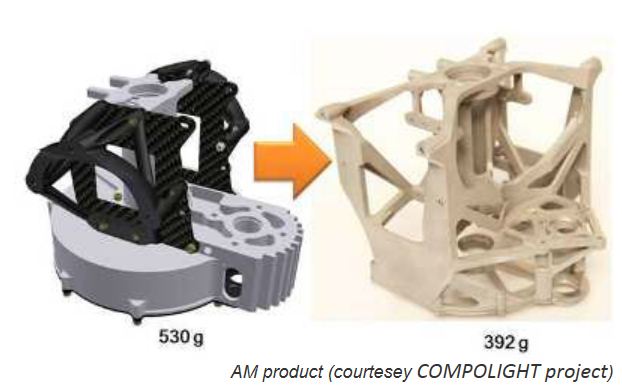Related Projects
... to SMARTLAM from the same FP7-NMP call
After this first phase, MINAM 2.0 “Paving the ground for the second generation of a highly effective, application oriented Micro-Nano Manufacturing community in Europe” was founded in October 2010 as a Coordination and Support Action (CSA) under the Seventh Framework Programme of the European Commission. First results of the already existing MINAM platform had been provided as input to the European Commission Programme, and therefore it served as a preparation for the MINAM 2.0 project.
- using Additive Manufacturing (AM) to produce monolithic tool inserts with integrated complex internal channels for efficient thermal management and process control
- developing enabling precision manufacturing technologies to post-process the tool insert features
- applying special metrology techniques based on computer-tomography (CT) to control the quality of the integrated complex internal channels
- developing handling system and high-speed in-line quality control system for non-statistic quality control and integrating it into an industrial production platform

The primary goal of HiPr is to develop and integrate all necessary base technologies which create the basis to control and monitor the condition of micro-tooling for complex high-precision 3D parts. This will be achieved by developing and integrating: in-depth process and material knowledge, in-line measurements, real-time predictive maintenance.

Due to the high potential of miniaturization and integration, with regard to the innovation degree, quality and sustainability requirements, the 21st century looks forward to the integration of new functions on plastic parts to produce smart plastic products, as markets are requiring traceability, security, communication as well as ergonomics.
So called Molded Interconnected Devices (MID) basically combine all the features of molded plastic parts with electrical conductive circuitry and electronics components assembly directly on the plastic packaging. MID lead finally to highly integrated multi-material and multifunctional 3D compact systems. With a 20% of growth per year since 2008, MID is the tomorrows converging technology for electronics and plastics.
To achieve advanced high precision and high quality 3D micro systems, the EU industry is facing the following MIDs bottlenecks:
- to be able to manufacture high precision 3D micro-parts integration plastics and electronics, including 3D plastic system carrier, 3D-conductive tracks and 3D electronics component assembly
- to be able to reduce the manufacturing cost by 50% in order for EU industry to be competitive with low-wage countries,
- to provide the industry with reliable, robust and in-line controlled manufacturing processes for plastics and electronics converging technologies.
3D-HiPMAS will overcome these challenges by providing the EU industry with a pilot factory based on 4 key technological building blocks enabling the manufacturing of low costs and high precision 3D multi-materials parts:
- 3D high precision plastics micro-parts
- 3D high definition conductive tracks
- 3D precision electronics components assembly
- 3D reliable and robust online monitoring and quality inspection system
These 4 technologies will be integrated in order to launch the future EU pilot factory
The consortium is composed of all key actors from the value chain, from the material manufacturer to the end-user.
Proof will be given on pilot production lines in industrial settings. HiPr will do this with a consortium of partners best-in-class in these fields. The methodology that will be used to come to efficient realization consists of : description of the process, measure tool performance, model based prediction of tool performance.
This methodology will result in reduction of:
- cost by >20%
- material and energy consumption by >30%
 The general objective of Hyproline is to strengthen the competitiveness of the European industry by introducing manufacturing methods, which will allow companies to
The general objective of Hyproline is to strengthen the competitiveness of the European industry by introducing manufacturing methods, which will allow companies to
- reduce time-to-market and number of rejects,
- make more customized and innovative products with a higher market value, and
- make products > 20% more accurate with considerable savings (>30%) in consump-tion of waste metal, fluids and services, with an equivalent reduction of CO2 emission.
By further developing the manufacturing process itself as well as by research and application work on materials, pre and post treatment of the parts produced and supporting software Hyproline adds capabilities to commercially available manufacturing systems, in terms of speed, product quality and versatility. By keeping focus on the entire process from conceptual outline of the product via product design, engineering and production planning to actual manufacturing and control of quality, the project contributes to the development of a versatile manufacturing process, suited for industrial produc-tion by SMEs of complex custom made metal (meso scale = order 10 mm) parts in small batches or even in one-of-a-kind production mode.
The Hyproline manufacturing concept will be demonstrated by its pilot implementation for serial production of customized high quality meso parts for two different industrial sectors:
- electronics and
- aerospace.
The EU-project Hyproline has started by 1 September 2012.
Within CassaMobile a mobile, flexible, modular, small-footprint manufacturing system in a 20’ ISO-container that can be easily configured for different products and processes is developed. The container format allows transport to provide on-site manufacturing anywhere, enabling the benefits of localised service delivery without duplication of equipment at multiple locations.
The integrated modular manufacturing system with standard interfaces allows an easy exchange of process modules. The process modules are inherently intelligent. Each module is equipped with its own control equipment and features a self-description, which in combination with the machine control system allows automatic configuration of the whole assembly system.
An additive manufacturing module enables the system to “3D print” customised components of virtually any shape. In-process inspection improves accuracy, reduces waste and eliminates manual quality control tasks. A pick and place module allows assembly of discrete components. Other processes, such as finishing, cleaning and sterilisation, can be easily integrated as additional process modules.
The concept will be demonstrated by three use cases: bone drill guides for orthopaedic surgery, medical orthotics and individual industrial gripping products. The use cases impose very different and challenging requirements for customisation: patient-specific parts, medical production, high demands for process stability etc.
The project will create significant impact by enabling manufacturers to respond to rapidly changing market dynamics with high value-added products whilst reducing time-to-market, cost, environmental footprint and set-up time. Industrial and scientific exploitation tracks are an integral part of the whole concept.
The purpose of the Diginova coordinating work is to determine the current status and assess and promote the expected potential of Digital Fabrication for the future of materials research and manufacturing in Europe, taking the Diginova scope as a starting point. A map of key material innovation and application domains, identification of key technology challenges and new business opportunities will be done. Identification and connection of main stakeholders through establishment of innovation networks centered around concrete identified business cases are essential tasks, to determine the added value and feasible routes to commercialization.
The findings will result in a Digital Fabrication roadmap describing new business as well as technology drivers, aligned with a map of the most attractive innovative product categories for applications of new materials and processes, derived from a well-founded business perspective. The roadmap will describe the most promising materials and material deposition and modification technologies and will point out the direction for innovation in materials and digital fabrication to transform EU industries from their 20th century analogue roots to their 21st century digital future.
Achieving the ambitions of the Diginova project will
- Create a paradigm shift in manufacturing that will open up huge opportunities for future growth for manufacturing and new material developement in Europe.
- Deliver a roadmap for Digital Fabrication drafted by the project partners together with all identified key actors. This will provide a meaningful framework and guideline for innovation for all actors in the innovation value chain.
- Help to eliminate compromises that reduce the functionalities of new advanced materials thereby maximising their potential value and shortening the time from lab to market.
- Lower barriers for adoption and application of advanced new materials leading to faster innovation cycles.
- Build better coordination networks of three key groups of stakeholders, centred around well described and widly recognized key application focus areas: materials developers, manufacturing equipment developers and application developers/owners.


SASAM's mission is to drive the growth of AM to efficient and sustainable industrial processes by integrating and coordinating Standardisation activities for Europe by creating and supporting a standardisation organisation in the field of AM.
The Additive Manufacturing (AM) concept is based on additive freeform fabrication technologies for the automated production of complex products.
Additive Manufacturing is defined as the direct production of finished goods using additive processes from digital data. A key advantage is that AM eliminates the need for tooling, such as moulds and dies, that can make the introduction of new products prohibitively expensive, both in time and money. This enables the production of forms that have been long considered impossible by conventional series production—in fact, they can be created fast, flexibly, and with fewer machines.
ManSYS (MANufacturing decision and supply chain management SYStem for additive manufacturing ) aims to develop and demonstrate a set of e-supply chain tools; to enable the mass adoption of Additive Manufacturing (AM). This will allow businesses to identify and determine the suitability of AM for metal products, and subsequently manage the associated supply-chain issues and facilitating open product evolution.
The proposed e-supply chain solution will combine all aspects of AM including; multiple build platforms (Laser and Electron-Beam technologies), modelling, post-processing (Machining, Finishing and Heat-Treatment) and 3D scanning techniques. This will give a press-button solution to the production and challenges of new products. The integrated solution will offer a knowledge driven manufacturing process with significant production benefits; customisation, automation, self-management and reduced material usage and waste. The integrated approach will be assessed using a range of demonstration scenarios to assess and highlight:
- Cost-Savings: Assessment of parts (including design optimisation) against existing manufacturing methods allowing businesses to decided if AM is an appropriate manufacturing approach.
- Re-action to Customer Need: Demonstrator parts from industry (initially aerospace, and medical) validated by ManSYS end-users, including the ability to allow rapid design variations.
- Robustness of Supply Network: Development of QA/QC procedures and protocols to allow operation at multiple-locations and across multiple-machines. Demonstrating the ability to handle supply-chain interruptions and improve robustness.
- Environmental Assessment: Measure the embedded CO2 of the parts made, including assessment of the ability of AM to optimise part design.
The ManSYS solution will be based on only commercial AM management software ( Streamics ).
In today globalized world, companies are trying to remain competitive through the adoption of a strategy where high quantity production of goods is the leverage to reduce costs. By negating this approach, ADDFactor proposes the Mini-factories concept, which is conceived to be an innovative solution for most of the actors involved in the whole supply chain: the relationship between retailers and the manufacturing technologies will be considered and characterized by a new production framework concept, founded on central knowledge-based design and local distributed manufacturing.
This high-level concept will be applied focusing on need-driven products, and ADDFactor will manage the complexity of their design phase thanks to a direct connection with the retailer, that will provide biometric data of the customers as tacit requirements and aesthetics tests as explicit demands, being both fundamental for an effective individual personalization.
ADDFactor achievements will be focused on two different levels of manufacturing solutions, which will be placed:
- At retail environment, to consider products simple and/or reduced in terms of assembled components (i.e. orthotics or modular fashion heels and plateau);
- And at district level when the products are complex and the manufacturing procedures cannot be scaled at local level (i.e. sport shoes or complete customized fashion shoes).
Within this overall project concept, ADDFactor will structure its activities towards the achievement of different objectives, from diagnostic devices to advanced design tools in order to convert personal data in individual product specifications. The manufacturing is then guaranteed by a local manufacturing through novel ultra-fast and auto-configurable machines.
The mission of the NextFactory project is to develop and validate a new type of all-in-one manufacturing technology combining, for the first time, in a single piece of equipment, 3D freeform printing and ultra-precision 3D assembly. This highly flexible and scalable facility will empower microsystem manufacturers - and in particular SMEs - to effectively produce highly miniaturised Smart Products-in-Package (SPiPs) both in small series and high-throughput production of large parallel batches.
The project is driven and led by SME-owned use cases in medical, environmental and food processing, which represent an optimal combination of challenging requirements and high visibility for the new approach, providing a strategic direction to the project and validating the operability for a large variety of products: (i) oral sensors, requiring a one-piece-at a time customisation, (ii) microsensor chips for oxygen monitoring in closed compartments, and (iii) complex solar modules with circuits and capacitors. They will also be used for a proof-of-concept demonstration.
The impact expected from this development will be, depending on the use case, a 10 to 100fold reduction of the SPiP production lead time at low cost and with almost zero waste, inducing a paradigm shift in SPiP design & development and thereby freeing an unprecedented innovation potential in manufacturing intensive industries.
The NextFactory consortium will bring together a multidisciplinary group of leading edge SMEs and academic partners respectively contributing expertise in the new manufacturing technologies and the different application fields. NextFactory will last 4 years and work through develop-trial-improve iterations, aiming at satisfying increasingly challenging measurable objectives and delivering valuable intermediate results for the involved SMEs.
The MULTILAYER project is focused on the development of a new platform for the large-scale production of micro devices based on a technology we call “Rolled multi material layered 3D shaping technology”. In order to realise MULTILAYER in an efficient way, the work plan has been established with several sub projects that correspond to the different levels of organization, communication and research.
To pursue the objectives of MULTILAYER ten sub-projects have been defined:
- Products processes and specifications
- Tape development
- Tape 3D structuring
- Functional printing
- Post treatment/assembly
- Automation, integration and up-scaling
- Demonstration/prototypes
- Control, inspection and safety
- Dissemination and training Project management





